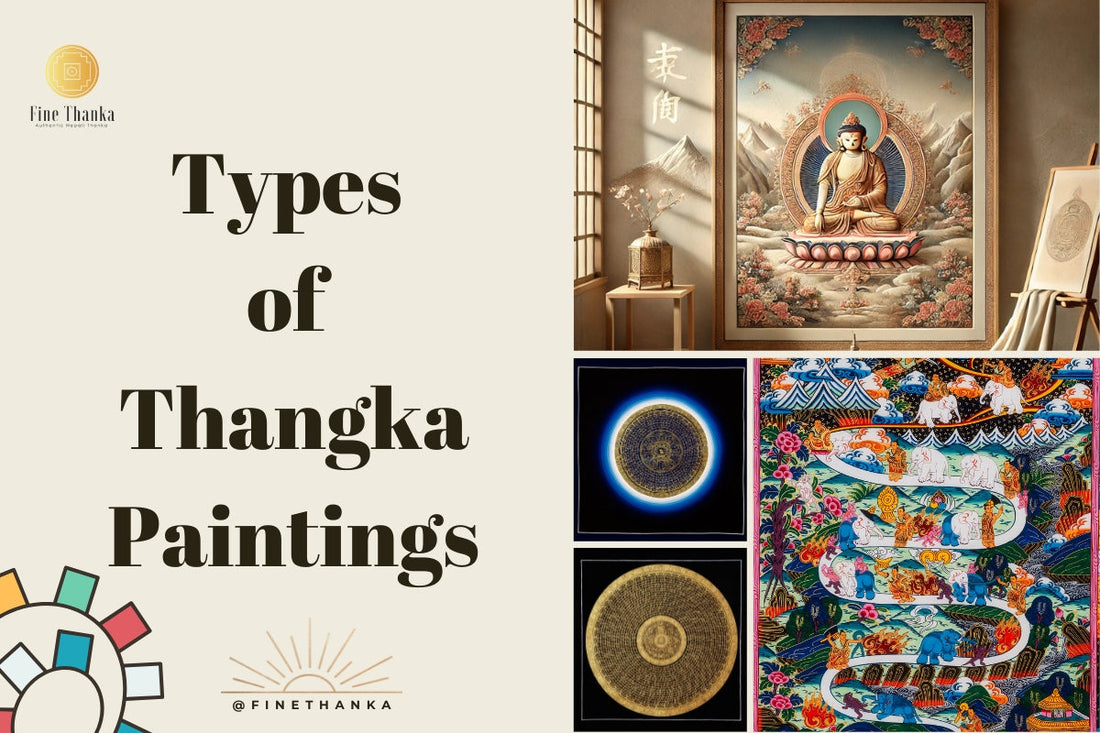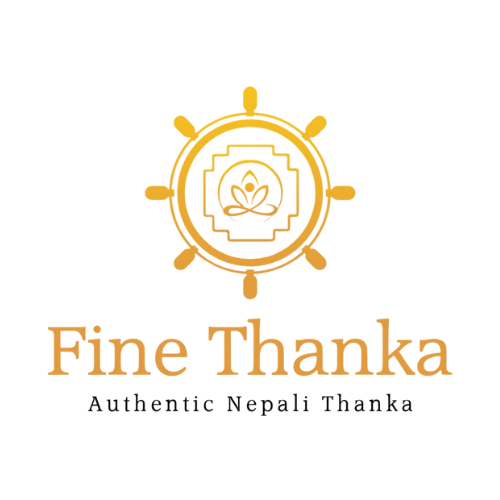
Types of Thangka Painting: A Complete Guide to Sacred Buddhist Art
Share
Thangka paintings, the timeless Buddhist art form born in the heart of Nepal and Tibet, weave a mesmerizing tale of spirituality.
If you're wondering, "Which type of Thangka should I choose?"—you’re not alone!
This guide is here to answer all your questions. Explore the diverse types of Thangka paintings, uncover their unique features, and discover their profound significance in Buddhist culture.
What is Thangka?
Thangka, also known as "Tangka" or "Thanka," is a captivating Tibetan art form deeply rooted in religious and cultural traditions. You’ll find these portable masterpieces not just adorning walls but also serving as meditation guides or teaching tools, embodying centuries of tradition. Their vivid colors and profound symbolism make Thangkas a cherished part of Tibetan Buddhism, much like how a mandala might captivate you during a meditative session or a spiritual class.
Types Based on Style
Tibetan Style
The Tibetan thangka painting stands out for its strict adherence to Buddhist iconography and symbolism. Every brushstroke follows precise proportions, colors, and compositions, ensuring spiritual accuracy over artistic freedom. Crafted with natural mineral pigments and gold leaf, these masterpieces often depict deit ies, mandalas, or scenes from sacred scriptures. Their intricate designs and deep symbolism make them cherished treasures in Tibetan Buddhism, playing key roles in ceremonies and personal devotion.
Newari Style
Straight from Nepal’s vibrant Kathmandu Valley, the Newari style brings together local artistry and Tantric Buddhist symbolism in a way that captivates you. Known for its intricate details and exquisite craftsmanship, this style often reflects Nepali architecture and culture. Interestingly, it heavily influenced Tibetan painting during the 15th and 16th centuries, blending seamlessly into their traditions. With their stunning brocade borders and artistic brilliance, Newari Thangkas are admired as masterpieces of artistic excellence.
Karma Gadri Style
Originating in eastern Tibet, Karma Gadri Thangkas blend traditional Tibetan iconography with the delicate elegance of Chinese landscapes. Known for its harmonious composition and serene brushwork, this style radiates tranquility and enlightenment. Rooted in the Karma Kagyu tradition, it began under the guidance of the 4th Karmapa in the 14th century. These Thangkas often depict religious figures and narratives with balance and precision, offering you a glimpse into Tibetan art’s spiritual depth and timeless beauty.
Modern Style
Modern Thangka art offers a refreshing twist by blending traditional techniques with contemporary creativity. While staying true to religious authenticity, artists now experiment with vibrant materials and innovative styles, making Thangkas accessible and relatable to a global audience. This approach breathes new life into classic themes, like deities and mandalas, allowing you to connect with the spiritual essence of Tibetan Buddhism through a modern lens.
Menri Style
The Menri style, founded by Manthangpa Manla Dondrub in the 15th century, captivates with its bold outlines, vibrant colors, and intricate details. Drawing roots from the ancient Bon religion, this style emphasizes spacious compositions adorned with Bon deities and symbols. With striking color contrasts and delicate gold accents, Menri Thangkas are designed to leave you in awe of their visual and spiritual impact.
Mandala Style
Mandala Thangkas are mesmerizing geometric masterpieces that represent the universe and the journey to enlightenment. Painted on silk or cotton using natural pigments, these artworks burst with vivid colors and durability. Each mandala intricately weaves deities, symbols, and teachings into a cosmic map, inviting you to explore the profound spiritual teachings of Tibetan Buddhism.
Types of Thangka Based on Technique
Painted Thangkas (Tib. bris-tan)
Painted Thangkas are the most recognizable form of this sacred art, crafted with traditional mineral pigments on cotton or silk canvas. These pieces follow strict iconographic guidelines and go through several stages: surface preparation with natural gesso, sketching the main figures, applying mineral pigments, and final outlining with gold to complete the divine imagery.
1. Multicolored Thangka (Tib. tson-tang)
Multicolored Thangkas are vibrant and full of life, with colors derived from natural minerals and plants. These pieces are created on cotton or silk canvases, with intricate outlines and layered pigments that bring depth and detail. Often depicting Buddhist deities and sacred scenes, these Thangkas serve as powerful visual aids for meditation and religious practice.
2. Black Background Thangka (Tib. nagtang)
With their striking contrast of gold line work on a deep black canvas, Black Background Thangkas exude power and intensity. These Thangkas are typically used to depict wrathful deities, highlighting their fierce energy and strength. The dark background enhances the gold details, creating dynamic and commanding imagery.
3. Gold Background Thangka
Gold Background Thangkas shine with a divine glow, symbolizing purity and auspiciousness. Often reserved for peaceful deities or enlightened beings, the golden hue adds serenity and spiritual light to the artwork.
4. Red Background Thangka (Tib. mar-tang)
Red Background Thangkas offer a warm, vibrant tone, often associated with themes of prosperity and compassion. The vermilion backdrop complements depictions of Bodhisattvas like Avalokiteshvara, emphasizing their qualities of care and enlightenment. The rich red background brings a sense of warmth and positivity to the detailed artwork.
5. Appliqué Thangka (Tib. go-tang)
Appliqué Thangkas are unique, crafted by sewing together colored fabrics to create images of deities or mandalas. While not strictly painted, this technique adds a three-dimensional effect and is particularly popular for large ceremonial Thangkas displayed during festivals. The vibrant fabric adds texture, depth, and a tactile beauty to the artwork.
6. Block Print Thangka (Tib. dpar ma)
Block Print Thangkas are created using woodblock printing to outline the designs on canvas, speeding up the production process while maintaining intricate patterns. After printing, artists fill in the outlines with vibrant colors, creating consistent and detailed imagery across multiple pieces. This method allows for the mass production of these sacred works without sacrificing quality.
Embroidery Thangkas (Tib. tsem-thang)
Embroidered Thangkas are the epitome of textile mastery in Buddhist art. Crafted with silk threads in a vibrant array of colors, these stunning works can take months or even years to complete. The delicate needlework creates layers of texture and gradation that painted Thangkas simply can't match, making them a rare and exquisite form of spiritual expression.
Lacquered Thangkas
Lacquered Thangkas, though less common, are no less magnificent. Built up with layers of lacquer on a wooden base, these Thangkas come to life with stunning designs. Artists often enhance the pieces with mother-of-pearl or gold leaf, giving them an extra layer of brilliance and elegance that catches your eye.
Woven Thangkas
Woven Thangkas are true rarities, created on specialized looms using silk or cotton threads. The weaving process demands extraordinary skill, as the artist carefully crafts the detailed imagery that defines Thangka art, turning fabric into a masterpiece.
Wooden Carved Thangkas
Wooden Carved Thangkas take Thangka art to a three-dimensional level. Carved from wooden panels, these pieces feature intricate relief work that brings the imagery to life. Often painted over the carvings, they blend sculpture and painting, offering you a unique fusion of art forms.
Metal Thangkas
Metal Thangkas, made from precious metals like copper, silver, or gold, showcase the versatility of this art form. Through repoussé and chasing techniques, artists create deeply detailed religious imagery that reflects both skill and spiritual devotion. These Thangkas exude an undeniable richness, making them an extraordinary addition to any collection.
Types Based on Depiction
Buddha Thangkas
Buddha Thangkas bring to life various forms of Siddhartha Gautama, often capturing key moments from his life or depicting aspects of his enlightenment. These paintings serve as powerful visual tools for meditation, guiding you through your spiritual journey with rich symbolism that reflects the Buddha’s wisdom and compassion.
Wrathful Deities
For a more dramatic and transformative experience, Wrathful Deity Thangkas feature fierce protectors like Mahakala and Vajrapani. These intense images symbolize the transformation of negative energy into wisdom, serving as reminders of the strength of compassion in overcoming obstacles.
Peaceful Deities
Peaceful Deity Thangkas offer a serene escape, with calm and wise figures like Amitabha and Manjushree. Their gentle expressions and peaceful postures invite you to cultivate tranquility and mindfulness, making them perfect companions for meditation and spiritual reflection.
Mahakala Thangkas
Peaceful Deity Thangkas offer a serene escape, with calm and wise figures like Amitabha and Manjushree. Their gentle expressions and peaceful postures invite you to cultivate tranquility and mindfulness, making them perfect companions for meditation and spiritual reflection.
Tara Thangkas
Tara Thangkas feature the compassionate female Buddha in various forms, such as Green Tara, Red Tara, and White Tara. Each version symbolizes different aspects of compassion and protection, helping you invoke blessings and guidance during meditation and daily life.
Jataka Stories Thangka
Tara Thangkas feature the compassionate female Buddha in various forms, such as Green Tara, Red Tara, and White Tara. Each version symbolizes different aspects of compassion and protection, helping you invoke blessings and guidance during meditation and daily life.
Types Based on Material
Gos-thang (Silk Thangkas)
Gos-thang, or silk Thangkas, are exquisite works of art crafted on delicate silk. Their shimmering surface and intricate designs, often enhanced with embroidery or appliqué, make them ideal for special religious ceremonies. Due to the fine nature of silk, these Thangkas are treasured for their beauty and rarity, often reserved for sacred occasions rather than everyday display.
Bris-thang (Pigment Thangkas)
Painted on cotton canvas using mineral pigments, these represent the most traditional form of Thangka painting. The cotton provides an ideal surface for detailed work.
Bris-thang refers to painted Thangkas, which are created using natural pigments applied directly onto a canvas made of cotton or silk. This category includes various subtypes based on background colors, such as:
- Tsho-thang: Multicolored background.
- Gser-thang: Yellow background.
- Mtshal-thang: Vermilion background.
- Dpar-thang: Black background.
- Dpar-thang (water print): A unique technique involving water-based printing methods.
Frequently Asked Questions
1. How long does it take to create a Thangka painting?
Depending on its complexity, a Thangka can take anywhere from several months to over a year to complete.
2. What makes a Thangka painting authentic?
Authentic Thangkas must follow specific iconographic guidelines, use traditional materials, and be created with proper spiritual intention. If you're looking for truly authentic Thangkas in Nepal, Fine Thanka Art is your trusted destination.
3. How should Thangka paintings be preserved?
Keep Thangkas in dry, shaded conditions, properly mounted, and clean them gently with a soft brush to maintain their beauty.
4. What determines the value of a Thangka?
The value of a Thangka is influenced by its age, condition, materials, the artist's skill, spiritual authenticity, and overall artistic quality.
Conclusion
At Fine Thanka Art, we offer the authentic Thangka paintings, crafted with love, precision, and spiritual intention. Whether you're drawn to serene Buddha depictions, vibrant wrathful deities, or intricate mandalas, you'll find the perfect masterpiece that speaks to your heart.
Add to Cart now to buy your Thangka online! Or, visit our store in Thamel to explore our exquisite collection in person.
